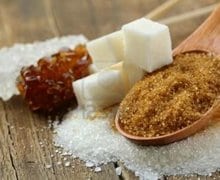Sugar is known by many names, and if you have diabetes, knowing those names is key to control
When you hear the word “sugar,” you probably think of that sparkly white stuff in the covered bowl on your breakfast table. But sugar is called by many names and if you have diabetes, knowing those names may be the key to good control.
My patients often ask why there are carbohydrates in meat like frankfurters, bologna or other processed meats. Or why their blood glucose levels are higher than usual after eating these foods. Hidden sugar is usually the cause.
Often times, food manufactures list these ingredients using unfamiliar terms, but with a little detective work you can find hidden carbs in your food. Carbs are important to monitor because the body breaks them down into sugar, raising your blood sugar levels.
Renée M. Simpson, a California-based registered dietitian, says, “Reading the nutrition label is always a good way to find hidden sugars.”
It’s also important to bear in mind that your body can’t tell the difference between sugars. “All of these [hidden sugars] are sweeteners, and they will all affect the blood sugar just as any other sweetener would,” says Simpson.
So let’s look at the different names you might find in an ingredient list—all of which mean sugar.
- Brown sugar is a combination of white sugar and molasses, which gives it a soft texture. Brown sugar comes in two varieties—light and dark. Light brown sugar has a delicate flavor contrasted by the more intense molasses flavor found in dark brown sugar. Light or dark, one tablespoon of brown sugar gives you 13.5g carbs and 52 calories.
- Carob powder is made from the pulp of the tropical carob tree. Carob is often used as a chocolate substitute because it tastes similar to chocolate. Other than the ingredients listed on a label, carob powder may be found in natural food and specialty food stores. One tablespoon of carob powder provides 10.5g carbs and 24 calories.
- Confectioners’ sugar, also called powdered sugar, is granulated sugar that has been crushed into a fine powder. It is often used to make icings and candy. It’s also used as a dusting on desserts. One tablespoon of confectioners’ sugar will give you 7.5g carbs and 29 calories.
- Not to be confused with high fructose corn syrup, corn syrup is a thick, sweet syrup created by processing cornstarch with acids or enzymes. Corn syrup is available light or dark. Light corn syrup has all the color and cloudiness removed; dark corn syrup has caramel flavor and coloring added to it. One tablespoon of corn syrup has 15.5g carbs and 57 calories.
- A tablespoon of granulated fructose has about the same number of calories and carbs as a tablespoon of granulated sugar, but fructose is almost twice as sweet. Fructose is naturally occurring in fruits and honey. You may also see it noted in the ingredient list as fruit sugar or levulose. One tablespoon of fructose, fruit sugar or levulose has 12.6g carbs and 46 calories.
- High-fructose corn syrup “is a very inexpensive sweetener that is used by manufacturers often to intensify the sweetness of the product,” Simpson says. It is no different than honey, sucrose or fruit juice concentrate when it comes to diabetes. They will all turn to glucose in your bloodstream. One tablespoon of high-fructose corn syrup has 14.4 carbs and 53 calories.
- Honey is a thick sweet liquid made by bees from the nectar of flowers. Sweeter than white sugar, honey is often touted as being a natural sweetener. Weighing in at 17.3g carbs and 64 calories per tablespoon, honey has more carbs and calories than high-fructose corn syrup!
- Molasses is the dark, sweet syrup remaining after sugar has been squeezed from sugar cane or sugar beets. Molasses can vary in color and flavor depending on how much sugar has been extracted. Light molasses is lighter in flavor and color. Dark molasses is thicker and less sweet than light molasses. Blackstrap molasses is very thick, dark and has a somewhat bitter taste. One tablespoon of molasses has 14.9g carbs and 58 calories.
- Raw sugar is the residue left after sugarcane has been processed to remove molasses and refine the sugar crystals. Because raw sugar may contain contaminants such as mold, 100 percent raw sugar is not available in the United States. However, turbinado sugar, which is raw sugar that has been steam cleaned is available. One tablespoon of turbinado or raw sugar has 15g carbs and 60 calories.
- Rapadura is an unrefined sugar, produced by evaporating the water from organic sugar cane juice. Unlike other sugars, rapadura is not separated from the molasses part of the sugar cane during processing. Organic Rapadura is made from organically grown sugar cane. Organic or not, it’s still sugar and one tablespoon of has 12g carbs and 45 calories.
- “Sucanat stands for SUgar CAne NATural, meaning that it is a product made from organic sugar,” Simpson says. “It still contains the natural molasses found in unrefined sugar.” Unlike regular brown sugar, sucanat is grainy, has a darker color and tends to taste like molasses. One tablespoon provides 12g carbs and 45 calories.
From theGrio.com






